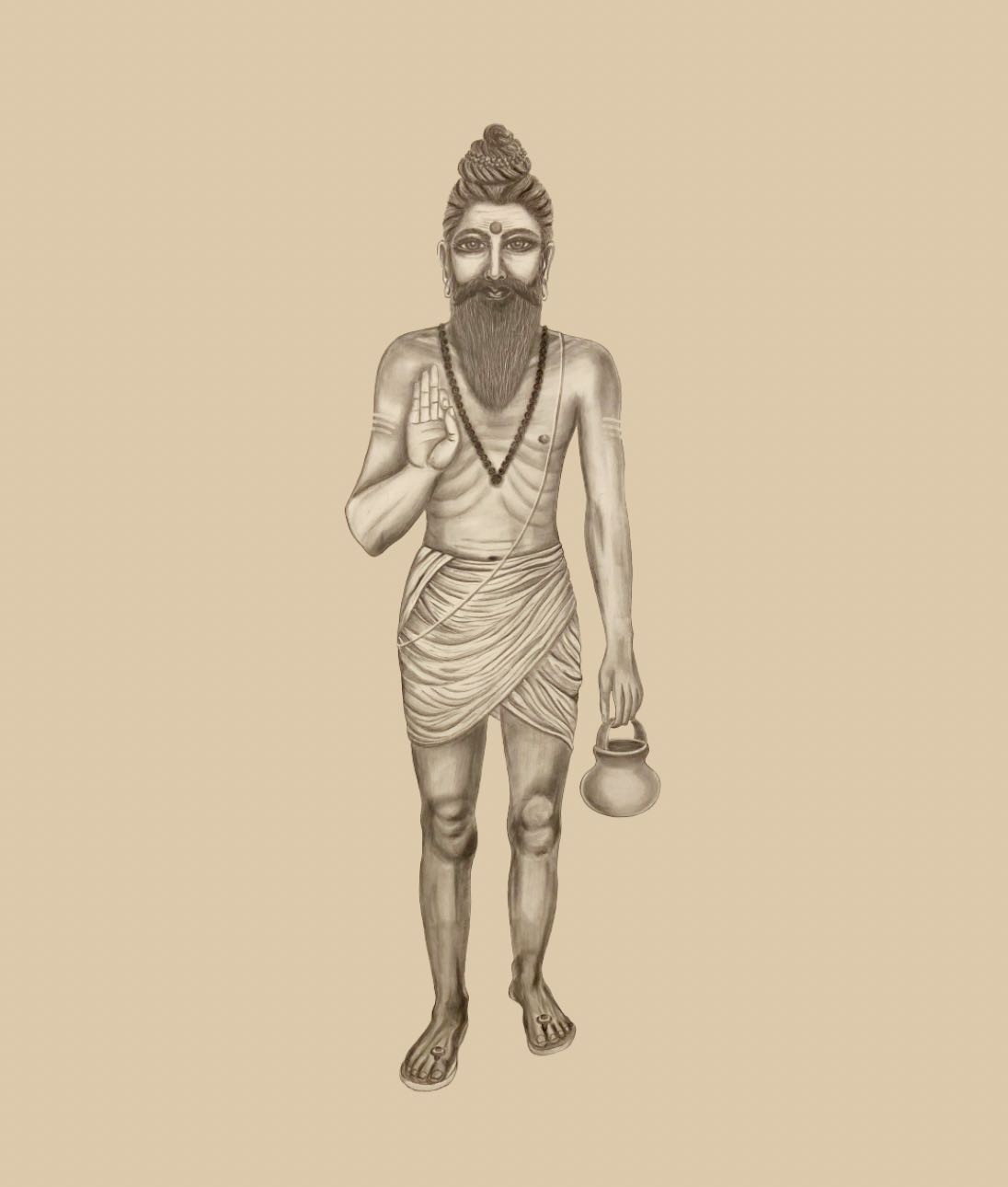- Edited
Unfortunately, not much is known about Śrī Rājarājeśvarānanda Tīrtha, the guru of Śrī Kalyāṇānanda Tīrtha.
Our knowledge of him is limited to:
- a disciple’s account of a vision,
- a story from “Gurudev Śivānanda” biography (see below) and
- confirmation of him being the Guru of Kalyāṇānandaji by Gurugaru during a discourse recorded on February 22, 1994.
We also had confirmation from Smt. Madhavapeddi Subbalakshmi Murthy, a disciple of Śrī Kalyāṇānanda Tīrtha, and from Śrī Kalyāṇānanda Tīrtha’s grandson, who mentioned that his grandfather got sannyāsa dīkṣā in Varanasi and later, both him and Śrī Rājarājeśvarānanda Tīrtha, were at one point in Rishikesh.
Based on this information that we have as of right now, we can say that: He was from the South and was a contemporary of Svāmī Śivānanda (1887-1963). At one time he resided not far from Swarg Ashrama in Rishikesh, at another time he was in Varanasi.
The writer of “Gurudev Śivānanda” mentions that Svāmi Adwayanandaji, who recounted the story, was able to personally speak to Rājarājeśvarānandaji about the account described in the book. It’s interesting to note that Swarg Ashrama is located on the bank of river Ganga, around 23 km from Śrī Kalyaṇānanda’s Bhadrakālī Pīṭham, which was built in the 1960’s.
Even less is known about Śrī Rājarājeśvarānanda Tīrtha’s, guru Śrī Ghanaśyāmānanda Tīrtha. His position in the parampara has been confirmed by both Gurugaru and Smt. Madhavapeddi Subbalakshmi Murthy. Our research has yielded documents mentioning Śrī Ghanaśyāmānanda Tīrtha, a daṇḍi sannyāsi, who established Veda Vedanga Vidyālaya and Mumukshu bhavan in Varanasi in 1929. He was a great Sanskrit scholar and expired in 1955. However, at this point, it’s unclear if he is indeed a Guru in our Parampara, and more research and conclusive evidence is needed to make that determination.
1. Disciple's Vision:

Years ago an old disciple of Guruji [who wished to remain nameless] once, during the morning mediation, had an unusual vision that left her speechless. In front of her, she saw standing a tall sadhu who was holding a water pot in his left hand and his right hand was showing a cin mudrā. He was smiling, didn’t really say anything, and after some time disappeared. After sharing a story with Guruji and Aiya, both Gurus confirmed that it was indeed Śrī Rājarājeśvarānanda Tīrtha.
Using a detailed description supplied by this disciple, one of the devotees was kind enough to create a rendition of Śrī Rājarājeśvarānanda Tīrtha that you see above.
2. Support from Gurugaru
In this snippet audio recording from 1994, one can hear Gurugaru mentioning the names of Śrī Rājarājeśvarānanda Tīrtha and the next Guru in our lineage - Śrī Ghanaśyāmānanda Tīrtha.
3. Darśan of the Divine Mother
From the Book “Gurudev Śivānanda” Authored by Svāmi Veṅkaṭeśānanda, 3rd Ed. (January 1, 1961), (Pages 171-173).
In regard to the 'Namaskar Sādhana' demanded by The Whip, we have some very interesting information. Śrī Svāmi Advayānandaji, the great Gītā scholar, narrated the following anecdote to me during the course of a discussion:
"When Svāmiji was in Swarg Ashram, there was a neighbor of his called Rājarājesvarānanda, who was a worshipper of Devi. I once met him in Benares. When he found that I was also from the South, he put me up in his Kutir and gave me some food. In the course of a casual conversation later on in the day, he asked about me and where I came from. I told him that I was Svāmiji's disciple, and he remarked at once, with a smile: "Oh! You are the disciple of that Svāmi who prostrates to dogs, birds and donkeys!" He explained that he was not joking but was speaking the truth. He had seen Svāmiji bowing down to men of all kinds, and even to animals. To him everything is God. 'Everything is Brahman,' is his constant Bhav. The Svāmi crowned his story with the following narrative: "Rājarājesvarānandaji was doing rigorous Sādhana with Saptashati Parayana, worship of the Divine Mother, and Japa and meditation. The Sādhana went on for years —nearly twelve years —and there was no indication of any progress or Siddhi. Durgā Pūjā came. This Svāmi had nothing to celebrate the Pūjā with, and he longed to worship the Devi with silk clothes, ornaments, and other Pūjā articles—but he had no money. The day before the commencement of the Navaratri, someone knocked at his door. He opened and saw some Punjabi girls. Each one had a plateful of silk clothes, fruits, money and ornaments. 'Svāmi Śivānandaji, your neighbor, asked us to give these to you for your Navaratri Puja.' The Svāmi believed them, thinking they were some of Svāmiji's devotees whom he had sent. He asked them who the plates belonged to, and they answered: "The Kshetra.' He went to Svāmiji's Kutir and found it bolted from the inside, as usual. He knocked and Svāmiji opened. He asked: 'Who were those Punjabi ladies, Svāmiji?' 'Which Punjabi ladies?' 'Those that you had sent to me with silk clothes and ornaments.' 'I did not send anyone!' replied Svāmiji. Rājarājesvarānandaji was mystified and ran to the Kshetra office. The ladies were not there.”
Adwayanandaji said: "He told me about the incident with tears in his eyes. ‘I had been doing intense Sādhana for the darśan of Mother for so many years. This Svāmi Śivānanda knew no Tantrik Sādhana for all I knew. Yet when Mother chose to grace me, it was at Śivānandaji's Prerana! She gave me ornaments and silk clothes and gave him Ātma Sākṣātkara.”


